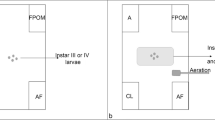Summary
On the bionomy and economic importance of Chrysopa carnea Steph. (Neuropt., Planip., Chrysopidae).
In the following the larvae of twoChrysopa carnea generations are described with regard to their need of lachnidae and eggs of lachnidae as food supply during their eating-period and the egg laying of the imago. They easily can bear fasting periods of four days. The early summer-generation has a developing period of larvae of 22 days during which it casts the skin twice. They need an average diet of 9Cinaropsis pilicornis units per day which corresponds to their daily birth rate in the same period of time.
The late autumn generation has a 93 day developing period of larvae during which they cast the skin four times an they generally suck out 3,2 eggs of theCinara piceae. One singleChrysopa carnea larva is thus albe to destroy the eggs layed in autumn by 38 femaleCinara piceae or by 150 femaleCinaropsis pilicornis.
Similar content being viewed by others
Literaturverzeichnis
Bänsch, R., 1964: Vergleichende Untersuchungen zur Biologie und zum Beutefangverhalten aphidivorer Coccinelliden, Chrysopiden und Syrphiden. — Zool. Jahrbuch Abt. Syst, Ökol. Geogr. Tiere, 91, 271–340.
Bosch, R., von demLeigh, T. F., Gonzalez, D., Stinner, R. E., 1969: Cage studies an predators of the bollworm in cotton. J. econ. Ent. 62, (6) 1486–1489.
Branigan, E. J., 1915:Chrysopa californica. In Mo. Bul. State Com. Hort (Cal)4, No. 8 p. 400; No. 10 p. 484.
Dinikins, R. L., Brazzel, J. R., Wilson, C. A., 1970: Species and relative abundance ofChrysopa, Geocoris andNabis in Mississippi cotton fields. J. econ. Ent.63, (2), 660–661.
Lindgren, P. D., Ridgway, R. L. Jones, S. L., 1968: Consumption by several common arthopod predators ef eggs and larvae of twoHeliothis species that attack cotton. Ann. ent. Soc. Am.61, (3), 613–618.
Ridgway, R. L., Jones, S. L., 1969: Inundative releases ofChrysopa carnea for control ofHeliothis on cotton — J. econ. Ent.62, (1), 177–180.
Ridgway, R. L., Morrison, R. K., Badgley, M., 1970: Mass raring a green lacewing. — J. econ. Ent.63, (3), 834–836.
Scopes, N. E. A., 1969: The potential ofChrysopa carnea as a biological control agent ofMyzus persicae on Glasshouse chrysanthemums. Ann. appl. Biol.64, (3), 433–439.
Sundby, R. A., 1966: A comparative study of the efficieny of three predatory insectsCoccinella septempunctata L. (Coleoptera, Coccinellidae),Chrysopa carnea St. (Neuroptera, Chrysopidae), andSyrphus ribesii L. (Diptera, Syrphidae) at two different temperatures. — Entomophaga11, (4), 395–404.
Additional information
A - 1190 Wien, Bockkellerstraße 1/4/1
Rights and permissions
About this article
Cite this article
Egger, A. Zur Biologie und wirtschaftlichen Bedeutung vonChrysopa carnea Steph. (Neuropt., Planip., Chrysopidae). Anz. Schadlingskde. Pflanzen-Umweltschutz 47, 183–189 (1974). https://doi.org/10.1007/BF02308834
Issue Date:
DOI: https://doi.org/10.1007/BF02308834




